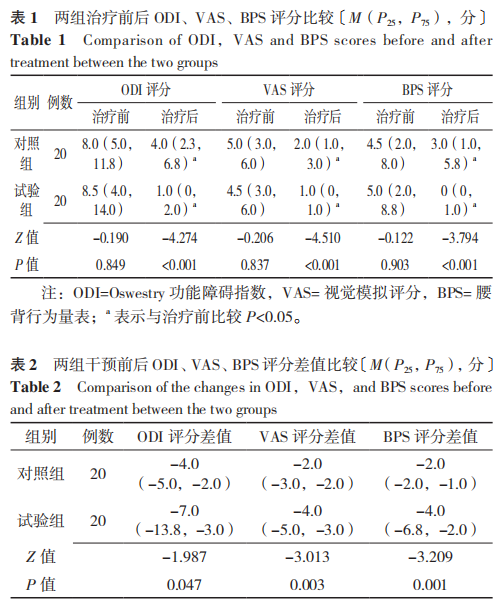Key words: Low back pain; non-specific low back pain; low back core training; anti-gravity treadmill; reverse walking training; NASA
Objective: To explore the effect of anti-gravity treadmill system reverse walking training combined with conventional low back core training in the treatment of non-specific low back pain.
Methods: 40 patients with non-specific low back pain who were treated at the Rehabilitation Medicine Center of Zhongshan Hospital Affiliated to Fudan University from July to December 2022 were divided into an experimental group (20 cases) and a control group (20 cases) according to the random number table method. The control group received conventional low back core training, and the experimental group used an anti-gravity treadmill system to perform reverse walking training on the basis of the control group. The Oswestry Disability Index (ODI), Visual Analog Scale (VAS) and Back Behavior Scale (BPS) scores of the two groups of patients were evaluated before treatment and 4 weeks after treatment. Results There was no statistically significant difference in the ODI, VAS and BPS scores between the two groups before treatment (P>0.05); after 4 weeks of treatment, the ODI, VAS and BPS scores of the two groups of patients were lower than before treatment, and the test group’s The ODI, VAS and BPS scores were lower than those in the control group (P<0.05); the difference in scores between the two groups before and after treatment was statistically significant (P<0.05).
Results: The reverse walking training of the anti-gravity treadmill system has a definite effect on improving the pain level and overall condition of the low back in patients with non-specific low back pain, and is worthy of clinical promotion.
The article is cited in: Chinese General Medicine ›› 2023, Vol. 26 ›› Issue (33): 4203-4206.
Article link: Anti-gravity treadmill system’s reverse walking training combined with conventional low back core training treatment
Nonspecific low back pain (NLBP) refers to a disease that excludes known diseases or pathological changes and causes persistent pain and weakness in the lumbosacral region, with or without radiating pain in the lower limbs, and limited activity. Epidemiological studies show that 50% to 80% of adults will experience low back pain in their lifetime, and NLBP accounts for approximately 90%, causing serious impact on patients’ functional activities, physical and mental health, and quality of life. The disease lasts for a long time and is prone to recurring or progressive exacerbations, making it a difficult problem for rehabilitation treatment. Currently, common treatment methods include preventive treatment, acupuncture and massage, exercise therapy, physical factors and minimally invasive treatments. Most patients’ symptoms improve after treatment, but core functions such as waist and abdominal muscle strength, endurance, and proprioception have not yet recovered. The recurrence rate within 1 year is as high as 70%. This study uses reverse walking training on an anti-gravity treadmill combined with conventional low back core training to treat NLBP, and uses Oswestry Disability Index (ODI), Visual Analogue Scale (VAS) and Low Back Behavior Scale to treat NLBP. (Back Pain Classification Scale, BPS) to evaluate the efficacy.

The control group was given conventional rehabilitation treatment including massage acupoints, neuromuscular electrical stimulation, infrared therapy, and gluteal bridge training. The details are as follows: (1) Massage acupoints treatment: use elbow rolling and palm kneading on the patient’s lumbosacral and thumb areas. Knead the patient’s Shenshu, Yaoyanguan, Weizhong, Chengshan and other acupoints according to the patient’s tolerance, 15 minutes/time; (2) Neuromuscular electrical stimulation: use a nervous system electrical stimulator to act on the patient’s painful and uncomfortable parts , choose the “analgesic and anti-inflammatory” prescription, and the stimulation intensity is based on the patient’s tolerance, 20 minutes/time; (3) Use infrared rays to treat the patient, adjust the setting to irradiate the lumbosacral buttocks, and prevent burns during the process, 20 minutes / times; (4) Glute bridge training: divided into 3 parts: double bridge, single bridge and ball bridge training.
The experimental group added reverse walking training based on anti-gravity treadmill to the control group. The patient puts on suitable specific shorts and stands on the anti-gravity treadmill. The therapist gradually reduces the weight loss and adjusts the walking speed according to the patient’s physical condition and tolerance. During the whole process, the therapist pays close attention to whether the patient feels any discomfort. If the patient experiences chest tightness, dizziness, or fatigue, he should stop training immediately and pay attention to the patient’s subsequent status. The walking time starts from 10 minutes and gradually increases to 20 minutes according to the patient’s condition, 2 times/week for 4 consecutive weeks.

The anti-gravity treadmill system is composed of a pneumatic system and a treadmill system. The technology comes from NASA. It is a type of weight loss support walking training. It can reduce metabolic demand and skeletal muscle load during use. In recent years, it has been favored by rehabilitation therapists due to its significant auxiliary effects in the fields of stroke, spinal cord injury, hip, knee and ankle joint injuries. This study innovatively applied the reverse walking training mode of the anti-gravity treadmill system to patients with NLBP and achieved significant results. Compared with simple backward walking training, reverse walking training on an anti-gravity treadmill has the following advantages: (1) The backward walking speed and time can be set according to the patient’s physical condition, which is easy to quantify; (2) The patient can The visual feedback from the front screen helps correct bad gait, thereby correcting the movement pattern of the waist and back muscles; (3) The gravity-reducing environment of the air bag can effectively reduce the tension of the lumbosacral muscles and reduce pain and discomfort during walking; (4) The airbag is wrapped around the patient’s waist to prevent falls, making the patient safer during the walking process. Especially for elderly patients, it can help them overcome their fear and increase their sense of security.
In summary, the anti-gravity treadmill system’s reverse walking training combined with low back core muscle strength training can indeed improve the low back pain and functional status of patients with NLBP, and is worthy of clinical promotion.